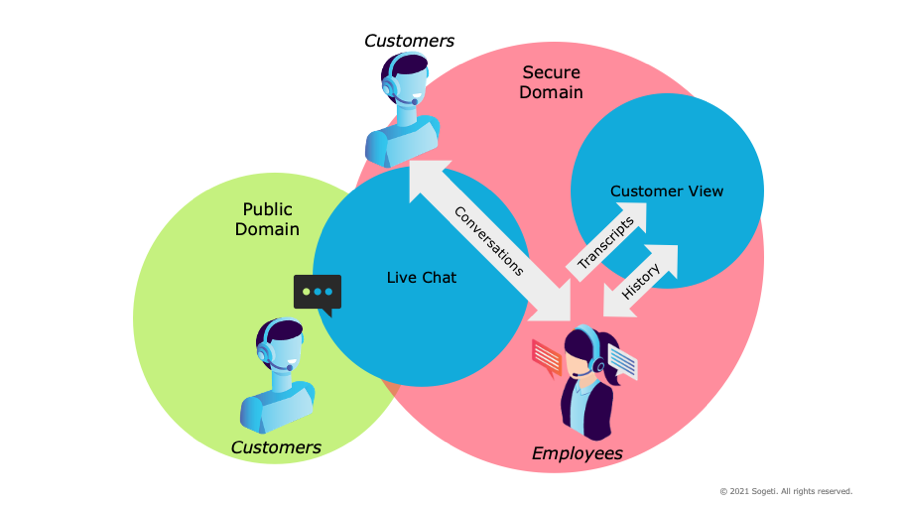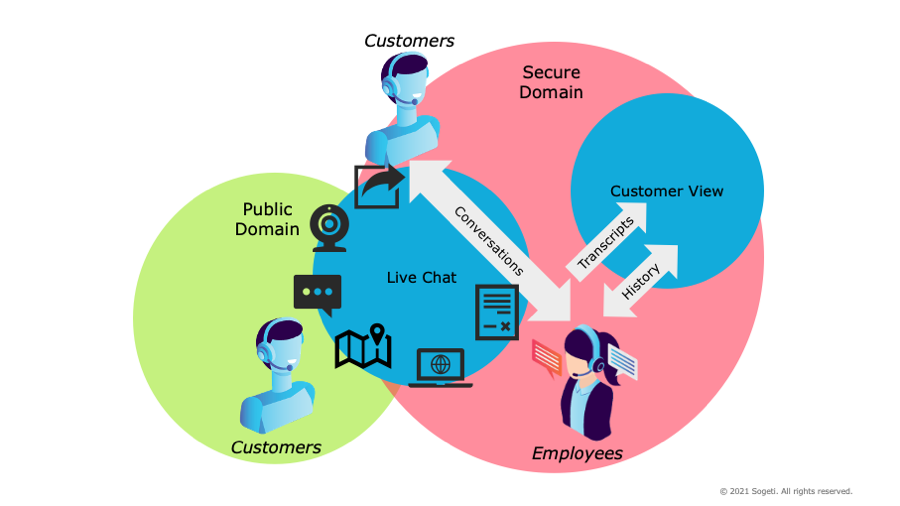
In a series of blogposts I’ll be sharing some learnings with regards to enhancing live chat, introducing conversational AI and scaling up with a bot at a banking organization. Most of these learnings would apply as well for other industries where investments are made to enhance customer service channels and live chat in specific. Let’s start with a short introduction and some context.
We are living in a 24×7 economy. People are used at doing online transactions at any time, any place and on any device. Looking i.e. at a banking organization customers are by default not visiting branch offices anymore. At the same time there is still a need for personal contact for all kinds of matters. Customers can be in touch through phone, but other contact channels have appeared over time, like i.e., live chat, video calling and social media.
Customers are increasingly diverting to online channels and this has accelerated even more with the COVID 19 pandemic restrictions in place. Customer support organizations have been adapting constantly serve the customers in several ways. At the same time employees have diverted to working remotely. All this has resulted in a heavier utilization of online contact channels while being under pressure to save costs.
How can organizations keep their service levels up to par and how do we create opportunities for personal contact with customers in this new reality? What are the contributions of Bots, Conversational AI and Intelligent Routing mechanisms to creating new opportunities for personal contact? What should be getting focus when your live chat channel is growing in volume?
Before we dive into topics such as Bots and Conversational AI I will elaborate more on live chat as a contact channel and how it can evolve over time.
Get your live chat foundation in place
As customers are used at doing online transactions 24×7, the expectations are changing towards customers service and live chat as a contact channel. In essence live chat is a synchronous communication channel which allows customers to directly communicate with employees by sending text messages back and forth. On the customer facing side you would at least need a basic chat interface to enter text messages and, on the contact center side, an interface to respond to these messages.

Live chat can be offered through a public environment (where the customer is anonymous) and through a secure environment (where the customer is identifiable, like i.e. after signing in). If live chat is offered on both a public and secure environment, consider options to redirect (and onboard) already existing customers to your secure environment and let them start the conversations from there. As the customer can be identified in a secure context a more personal experience for both the customer and the employee is possible. With permission from the customer, historical data related to earlier interactions should then also be accessible for employees.

With the introduction of messenger channels, a chat conversation is changing into a more a-synchronous way of communication as customers are not always expecting an instant response.
For the sake of this series of blog posts I assume that live chat is offered as a synchronous communication channel and that it operates in a secure context. This means that, in most cases, direct communication is possible with an employee or a (chat)bot and that the customer can be identified. Next to that I also assume that a live chat channel is already in place, a certain volume of conversations is handled and your strategy is to grow this into a more mature contact channel.
Keep on enhancing your (live) chat channel
Live chat systems should offer advanced routing and queueing mechanisms to make sure that conversations (initiated by customer) are routed correctly to employees with the right knowledge. Depending on the amount of products and services offered by the organization and the complexity, specific knowledge is required to answer related questions. If self-service options are available employees need to be able to point the customers towards these options or guide them through the process.
Let me elaborate on this a bit more. A chat conversation is always triggered by the user in a specific context. This context can be that the customer is coming from a product or service page inside your app, navigating from a product page or triggering a chat directly from a contact page. All these different sources (pages) are uniquely identifiable by their context variables. The better those context variables can be captured the faster one can determine how to (re) route a chat conversation. To make this more concrete I will give a short example. A chat application triggered on a service page related to investment banking should initially route any questions to a solution group with employees that can handle related questions. Employees assigned to this solution group are trained to answer specific questions related to the topic.
Traditionally chat conversations are limited to text only but when text is insufficient, additional options can be added such as supporting rich media (like i.e. markup and maps), video or audio conferencing, file sharing, co-browsing and even document signing.

Whether you are using a standard or custom chat frontend consider options to experiment with elevating live chat conversations to voice/video calls. To support your roadmap, look for opportunities to easily enhance your live chat by integrating with platforms or backend systems for inbound and outbound contact routing, customer tracking (CRM), document sharing and chatbot intelligence.
Customer should eventually have instant access to the best support mechanisms for issues that they experience. Life chat can be the ideal contact channel for further experimentation as it is easily accessible, allows a continues dialogue across multiple channels, offers a rich set of features and options for personalisation. Before we discuss on further enhancements, we first need to get a better understanding on how your live chat is performing. More about this can be read in the next blog post.
Thanks to Emil Wesselink and Chris den Arend for sharing their feedback and suggestions.
Sources
https://www.callcentrehelper.com/best-practices-to-improve-live-chat-120603.htm

 English | EN
English | EN 
